 There’s a Hawaiian saying that goes something like, “The weather doesn’t make a day.” This proved true on the unseasonably cold, wet Spring day I visited the Truppas at Monferrato, their northern Italian base half way between Turin and Milan. Valentina, at only 27 years old, is one of the most beautifully effective riders I’ve seen. Her father and coach, Dr Enzo Truppa, himself an O level judge and former international Grand Prix rider, is a walking encyclopedia of classical equitation. My visit is like a personal masterclass, so generous were they in sharing their knowledge.
There’s a Hawaiian saying that goes something like, “The weather doesn’t make a day.” This proved true on the unseasonably cold, wet Spring day I visited the Truppas at Monferrato, their northern Italian base half way between Turin and Milan. Valentina, at only 27 years old, is one of the most beautifully effective riders I’ve seen. Her father and coach, Dr Enzo Truppa, himself an O level judge and former international Grand Prix rider, is a walking encyclopedia of classical equitation. My visit is like a personal masterclass, so generous were they in sharing their knowledge.
When I arrive, Valentina is warming up Fixdesign Chablis. The 15-year-old chestnut she rode to many successes in young rider classes, including two of her record three European Championships. Chablis is affectionately known as Valentina’s ‘boyfriend’… Enzo explains: “Chablis was the most difficult horse because he was so dominant. Even some of the top trainers couldn’t fix his problems. I wanted to sell him but Valentina wouldn’t let me. Only Valentina can teach him. He accepts only her.”
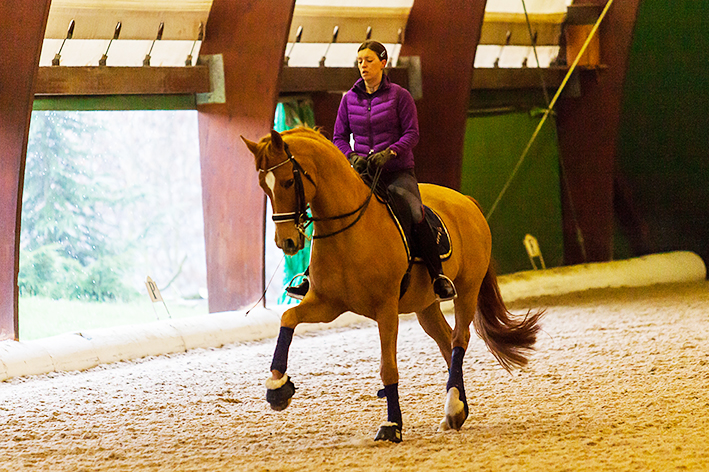
Valentina and ‘her boyfriend’ Chablis
The training is soft and correct, the curb shank is vertical and the exercises are used to shape the horse. “We work always at making loose the horse. This is our mantra,” Enzo emphasises. Contraptions are unheard of in the stable. “Valentina has never seen draw reins in her life. She would not know how to fix a problem with them. She is only 160cm and just over 50kg, and look at the horse. So I can’t believe our method is too wrong.”
Working pirouettes, a couple of big trot extensions to finish and many “molto buenos” from the trainer, Chablis has done everything asked of him so the session is short and he is put away after being fed a lot of sugar!
While Fixdesign Eremo del Castegno (by Rohdiamant), Valentina’s Olympic partner is prepared for work, Enzo shows me around the stable. I can’t help notice how many horses are named after wine: Chablis, Sauvignon, Chardonnay. Enzo laughs, “Yes, the stable is really a cellar! We all get drunk. You know, this is actually the best wine growing region in Italy,” and like all good Italians, Enzo is a wine connoisseur.
The horses range from three years old (Eremo’s full sister) to 15-year-old Chablis. Treadmills are used for exercise and to keep the young horses moving when the Truppas are away at shows. There is also an indoor solarium that has colour therapy, to keep the horses happy during the Winter months.
Eremo is the superstar. He has a body like Rambo and is often mistaken for a stallion. At the London Olympics the owner of the two showjumping mares stabled next to him was a little worried, until she was assured he is a gelding…
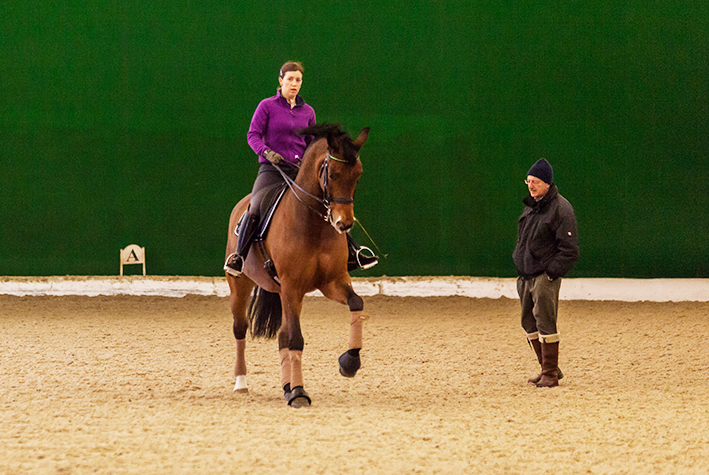
Enzo Truppa helps Valentina with Eremo del Castegno
Valentina is riding in new boots and a new prototype saddle and laughs through her pain, “Ah…it has to be done!”
Five minutes of walk at the beginning and then loosening canter work. Enzo continues to explain the training: “We never get so concentrated on the collected work that we forget the looseness and relaxation. How long we do it for depends on the horse.”
All the training is individualised for the particular animal. Some are warmed up in the trot, some the canter. Some are stretched long and some not. “Take Eremo, a German magazine once called him ‘The Gladiator’. He was so over-motivated but now he understands that we do the work together.
The Truppas do a lot of interval training. If an exercise is done properly, there is a pat and a walk. The biggest punishment is to repeat the exercise when it is wrong. They believe that if you punish a horse, he will never forget it and that horses give everything back… with interest.
Now 12, Eremo was chosen as a six-month-old weanling. The Truppas don’t buy trained horses but purchase them very young. They like to own the horses, so the training can progress at a speed suitable without the pressure of owners pushing the horses too quickly through the system.
Once the big bay has loosened up, it’s time to train what Enzo believes is perhaps the best piaffe in the world. The whip is taken away for the piaffe/passage as it can’t be used in competition. It is indeed perfect, showing why the horse usually gets awarded 9s and 10s for the pace. “Fantastico!” enthuses Enzo, “How do you like that?” he laughs.
The O level judge explains a situation that occurred at Stuttgart CDI, “One of the judges awarded a 7.5 for that piaffe without a comment. I believe marks below 8 should have a comment. Valentina asked me, ‘How do I make it 9.5 or 10?’ I told her the only thing you can do now is change your name to Truppenhoff or Van Truppen!”
Valentina hasn’t needed to resort to such tactics. She has had a great season on the World Cup circuit, and is headed to the World Cup finals after finishing in second place in the Western European League. It’s just fine-tuning now and a stress-free 20-minute session is all that is needed today, before the obligatory sugar.
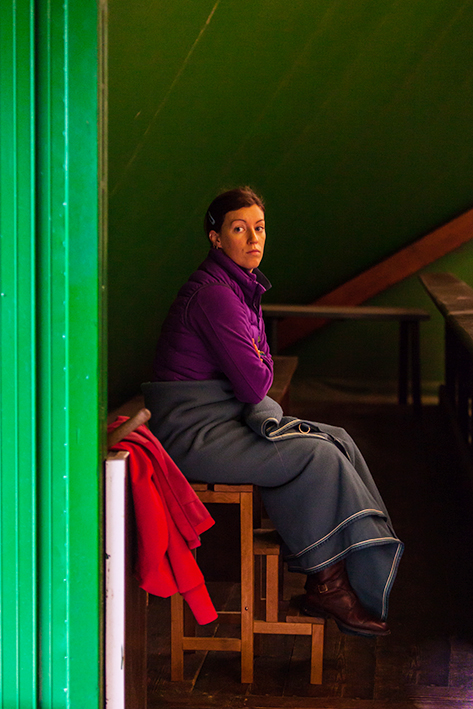
Valentina’s two top students enter the arena, and are wrapped up in a horse rug, the young rider takes on the coaching role. Frederica Scolari and Micol Rustignoli have already represented Italy as young riders with Valentina and now the young trainer wants her girls to make up the Italian team that goes to the European Championships in Herning later in the year. They both have their first qualifying marks, so it’s a reasonable goal. Although both are active and forward, Frederica’s horse is kept up in front while Micol is stretching hers long and low, “But never deep”, enforces Enzo, “I don’t believe in deep. But every horse is different and ridden accordingly.”
Micol’s horse has a short and therefore slightly tight back. She is tall, so she works to help him lift his back somewhat. Enzo explains again: “This is very interesting. The passage gets a bit tight, so then she trots to loosen the back before trying the passage once more. Never do we use force.”
Fixdesign Ranieri is next in the arena. Named after a Norman king, the big bay eight-year-old has just successfully begun his international career at Vidauban CDI. Enzo tells his story while Valentina loosens him up. “He is the first horse I have allowed Valentina to ride from three years old. Usually I don’t allow her to ride them until they are four; before that it can be too dangerous plus it’s not really training. But Valentina would say, ‘You don’t think I can do it’ and kept insisting so then I had to say ok, ride the bloody horse!”
Valentina explains: “He is like a little dog. He is a funny horse. I ride him sometimes without the saddle or bridle, the same as Eremo.” Valentina has started to do some Parelli work with her top horses to change their routine a little and give them mental relaxation. They play with big balls, walk over tarpaulins and get ridden in just a halter about every two months.
But today it is strictly dressage. Ranieri warms up in the canter. The quarters are engaged and the straightness checked then leg yield into half pass. “We do tonnes of counter-canter here,” Enzo explains. There is also an emphasis on working pirouettes. Next the trot is developed with shoulder-in and half pass. “Magnifico,” yells Enzo, before Valentina rides the first part of the Grand Prix.
When Ranieri throws in a quick 180 on the centreline, Enzo says dryly, “He is a horse with sense of humour, not always the same as the rider!”
But there is still sugar waiting for him at the end of his session. “The main danger to our horses here is diabetes. I had to stop standing next to the arena when Valentina competes this one as he used to stop all the time where I was, waiting for his sugar.”
It is then time for the younger horses to strut their stuff. Valentina is on Fixdesign Eremo’s brother Nilo. The rising six-year-old is so similar to his big brother in looks, but not in temperament; he can have his ‘moments’. The trot and canter are just so naturally swinging and the neck and back so correct, the young bay is on his best behaviour today. “We think the piaffe will be amazing too, but we’re not touching that yet”, says Enzo.
“Look at this horse, with such balanced paces it is easy to sit back and do nothing, but you must control the tempo. It is like a car with five gears, you have to use them, you have to control and master the tempo. This is so important and is the basis of our training.”
Valentina plays with the exercises: half pass off the inside leg, counter-canter and then just a couple of perfect, expressive changes off the track which were only introduced to the work last week.
Valentina checks that the horse is in front of her leg and checks the tempo control but never is she strong in her position nor does she over-organise the horse.
“Valentina has amazing natural feel. Look, I don’t have to say anything. She is also a master of balance. Even as a child, she’s always on the centre of gravity, never behind or in front. It is her gift,” says the proud father, who is also her biggest critic. “I’m more severe than the most severe judge. I have to commend Valentina for being so patient as I’m very picky.”
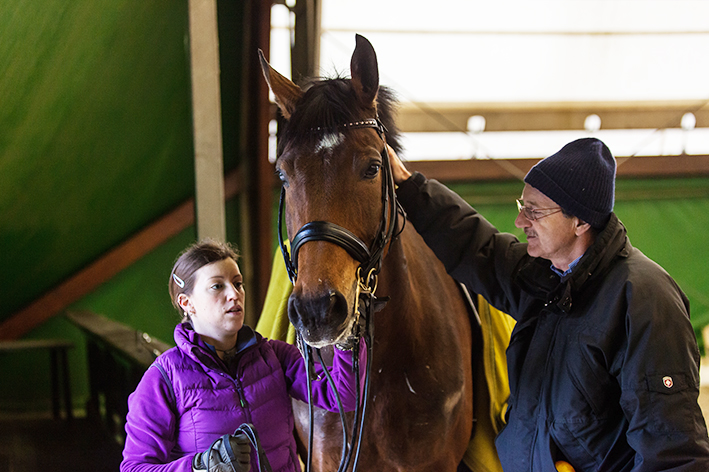
Other top trainers are sometimes brought to the stable to confirm the training. They have worked with Georg and Monica Theodorescu, Wolfram Wittig and Klaus Balkenhol. Valentina also spent some months with Hubertus Schmidt, an experience that changed her attitude towards the sport, not so much in the training, but her professionalism. She now rides many horses a day and runs the stable fully on her own. Enzo is busy in Milan during the week working as a tax consultant, only training Valentina three days a week.
We finish with the four-year-old Sauvignon who has already been lunged. “It is an idea from Georg Theodorescu. The lunging is the horse’s 10 minutes where he can do what he wants. Then it is the rider’s 20 minutes.” Valentina chats to the big baldy faced chestnut the whole time, “I have to be clear with him,” she says.
Enzo explains further, “With the young horses, we teach them a lot with voice; German words.”
Why German?
“It is like what Charles V is claimed to have said, ‘I speak Spanish to God, Italian to women, French to men and German to my horse.’ This is why German,” Enzo says with a wry smile.
Soon we are out of the cold and in the Truppa house meeting Enzo’s wife Anna, who turns out to be an incredible cook. Food and wine is indeed a religion in Italy and I fear I may have been converted.
Looseness and tempo are the key points to the Truppa training system. The horses are given all the time they need to develop, are treated as individuals and are never forced. Their system is kind, creative and classical and the results in the competition arena speak for themselves.
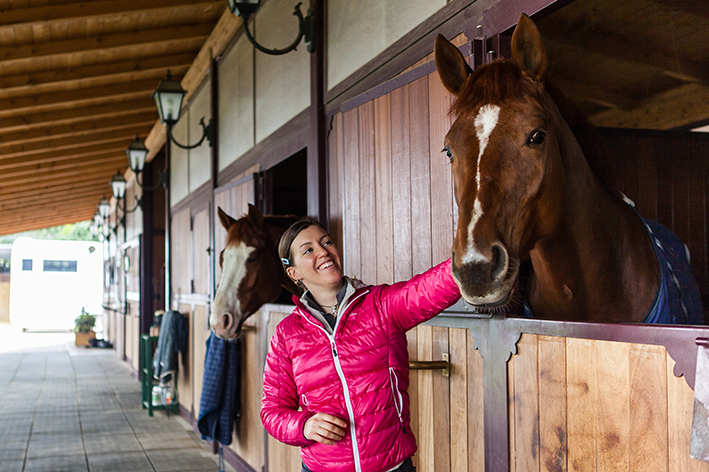
VALENTINA INTERVIEW
Do you have a favourite horse or is that like asking if you have a favourite child?
I have to say Fixdesgn Chablis. He has been with me so long and I had my best results with him until now. He’s my ‘boyfriend’ (although Valentina does have a real, live human one as well). Of course I love Eremo too.
What was the highlight of the London Olympics?
Well being my first Olympics it was a really big experience. The main thing was the atmosphere. Every competition we do the same tests, but at the Olympics there were so many people watching. Also, I stayed in the village for three days and being there with all the other different sports was very exciting.
What is your daily routine with the horses?
I start in the stable more or less around 08:30. I ride about seven horses a day, depending on what competitions I have coming up. I give lessons to students three to four days a week as well and finish the day around 17:30. Six clients are enough for me with my competitions.
As well as work, the young horses go into the paddocks when there is not so much rain! If this is not possible, they are lunged or get put on the treadmill. Sometimes I hack out as well.
You also do some Parelli work with the horses?
It is something fun for me and the horses. It’s another way to know more about your horse. This can be useful for riding. I started it with the older horses after the Olympics but have been doing it with the young horses for three to four years. I have help from Sergio Vezzoni.
With Eremo, it was not so easy to start with. He thought, ‘I am free!’ so he was a bit crazy. But now I can ride him with no saddle or bridle, but just at the walk.
What is the most important aspect of your dressage training?
If you ride young horses or Grand Prix, the most important thing is the basic work, then you can do everything. Sometimes during the week with Eremo and Chablis I do just basic work so the piaffe/ passage is there ready for the weekend when Dad is home to train me.
You have to find the right way with each horse, then it is easier.
I have also worked with other trainers. You have to try all the ways then you take what works and then make your own training system.
Biggest inspiration?
My Dad. I started riding in front of him when I was two years old. At four I rode my own pony, Rudy, both jumping and dressage until I was 12. But I also grew up watching Isabel and Anky as inspiration.
What do you get up to when you’re not riding?
Dinner, the cinema… simple things. I do like shopping. (At which point Enzo interrupts, “That she gets from the mother. It’s a very dangerous hobby! When they go out, my credit card becomes only a card.”)
So you followed your father into dressage and not your mother who is a dancer?
Oh. I dance much better with a horse!
